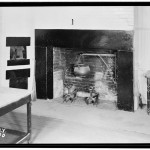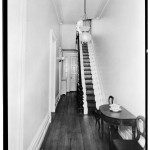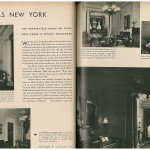Museum History
Miracle on Fourth Street
In 1832, 190 years ago, Joseph Brewster (a hatter by trade, who also speculated in real estate) built a brick and marble row house on Fourth Street in what was then a quiet, exclusive suburb of New York City. In 1835, three years later, prosperous merchant Seabury Tredwell purchased the house amnd moved in with his wife, Eliza, their eight children, and four Irish servants. They lived in the house for almost 100 years. Today, miraculously, the merchant’s house still stands. It has been open to the public as a museum since 1936. For the complete story, read Museum Historian, Mary L. Knapp’s new book, Miracle on Fourth Street: Saving an Old Merchant’s House.
1936-1965
When Gertrude, the youngest member of the large Tredwell family died in the house in 1933, her niece and heir, Lillie Nichols, prepared to sell the house and its contents at auction. Recognizing the historic value of an house that retained its original furniture and décor, and family possessions, a distant cousin of the family, George Chapman, arranged to purchase the house. He established a non-profit organization to operate it. For 25 years, Chapman personally provided almost all of the Museum’s funding. By 1959, however, when he died, time had caught up with the old house and it was perilously close to being beyond repair.
- In 1832, this house was built with an open hearth.
- Telegram, 1936.
- Parlor Hall, 1935
- House & Garden Magazine, 1944
In 1962, after three years with temporary caretakers, The Decorators Club of New York City, the oldest professional women’s organization of interior designers in the country, took on the Museum as a project. They hoped that by raising funds and restoring the furniture and reproducing the draperies and carpet, they could continue to present the house to the public.
In 1965, the Old Merchants House, as it was then called, was designated a New York City Landmark — the first in Manhattan — at the first meeting of the newly formed Landmarks Preservation Commission. A year later it was designated a National Historic Landmark.
1968-Present
 In 1968, serious water damage convinced the Decorators that extensive structural repairs were needed. They called on New York University Architect Joseph Roberto, pictured at left on the roof of the Merchant’s House, to advise them.
In 1968, serious water damage convinced the Decorators that extensive structural repairs were needed. They called on New York University Architect Joseph Roberto, pictured at left on the roof of the Merchant’s House, to advise them.
It was not long before Roberto, and his wife, Carol, fell in love with the house and committed to a complete structural and interior restoration. It was undertaken in four phases and took nine years to complete. Funding came from grants from the federal and state governments, private foundations, and corporate and individual donors. Phases One and Two included extensive exterior work. Phase Three covered interior structural work, and Phase IV, painting and restoring the interior, including restoration of the beautiful ornamental plaster work in the double parlor.
Throughout, Roberto scrupulously maintained the integrity of the original design, reusing original materials wherever possible. Then, members of The Decorators Club and the Robertos restored and reinstalled the collection of the Tredwells’ furniture and personal belongings. Reproductions of the original draperies and carpet, which had been in storage, were installed, and the Museum reopened to the public in November 1979. In 1981, the interior of the Merchant’s House was formally designated as a landmark by the City of New York. Today, it is one of only 121 interior landmarks. Only six are residences.
Following Roberto’s untimely death in 1988, with the help of a number of the city’s preservation organizations, the Museum raised seed money to hire its first professional staff.
In 1997, the Museum received a $1 million grant from the Vincent Astor Foundation, thus for the first time securing an endowment to provide for its future financial security. In 1999, the house joined the Historic House Trust of New York City, further ensuring its preservation for generations to come.
Sadly, today, after all it has been through to survive, the Merchant’s House faces a grave threat: a developer has plans to build an eight-story building next door. Click here to learn more and to help save the Merchant’s House.






